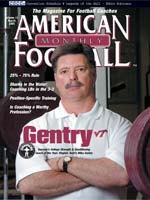AMERICAN FOOTBALL MONTHLY THE #1 RESOURCE FOR FOOTBALL COACHES
|
|
Article Categories
|
Postion-Specific Trainingby: Danny Arnold© More from this issue
When you lose your
keys, you’ve often left them in the last place you’d think
to look. Coaches and trainers, in search for a competitive edge,
do the same thing. Typically, they look outside for answers when
the secret ingredients for a successful training program might already
be right under their noses.
In all my previous articles I mention the importance of making all
your speed, agility and quickness drills to be sport-specific. In
fact, I’ve even mentioned the importance of going as far as
making your drills position-specific. In this article, I will again
illustrate the import....The full article can only be seen by subscribers.
Subscribe today!

|
|
|
NOT A SUBSCRIBER?
Subscribe
now to start receiving our monthly magazine PLUS get INSTANT
unlimited access to over 4000 pages of 100 percent football coaching
information, ONLY available at AmericanFootballMonthly.com!
|
|
|
HOME
|
MAGAZINE
|
SUBSCRIBE
|
ONLINE COLUMNISTS
|
COACHING VIDEOS
|
Copyright 2025, AmericanFootballMonthly.com
All Rights Reserved
|






